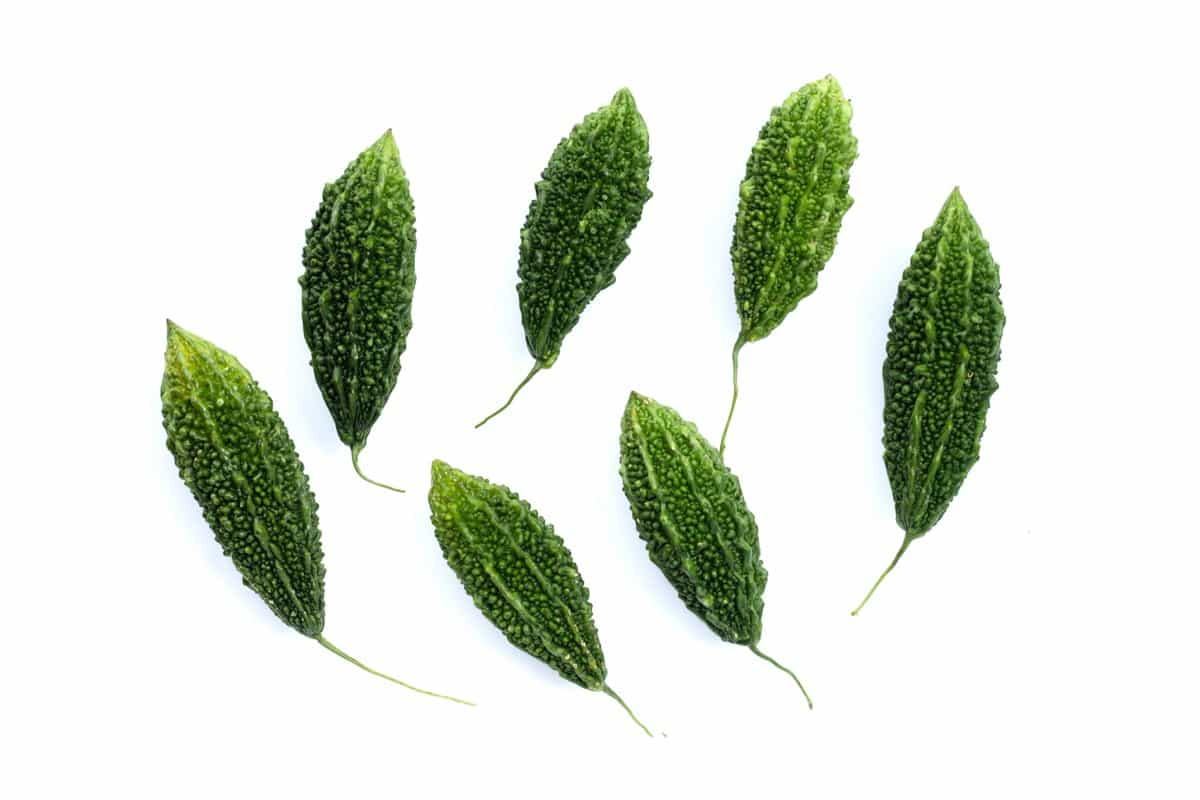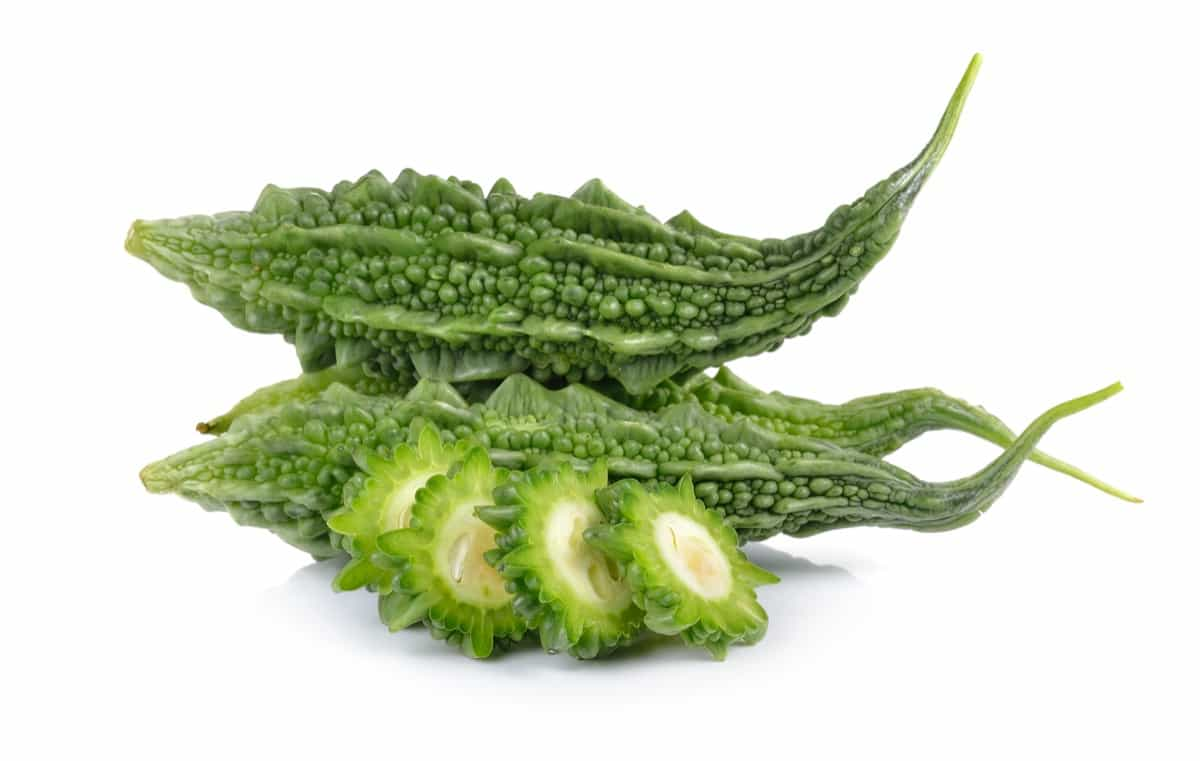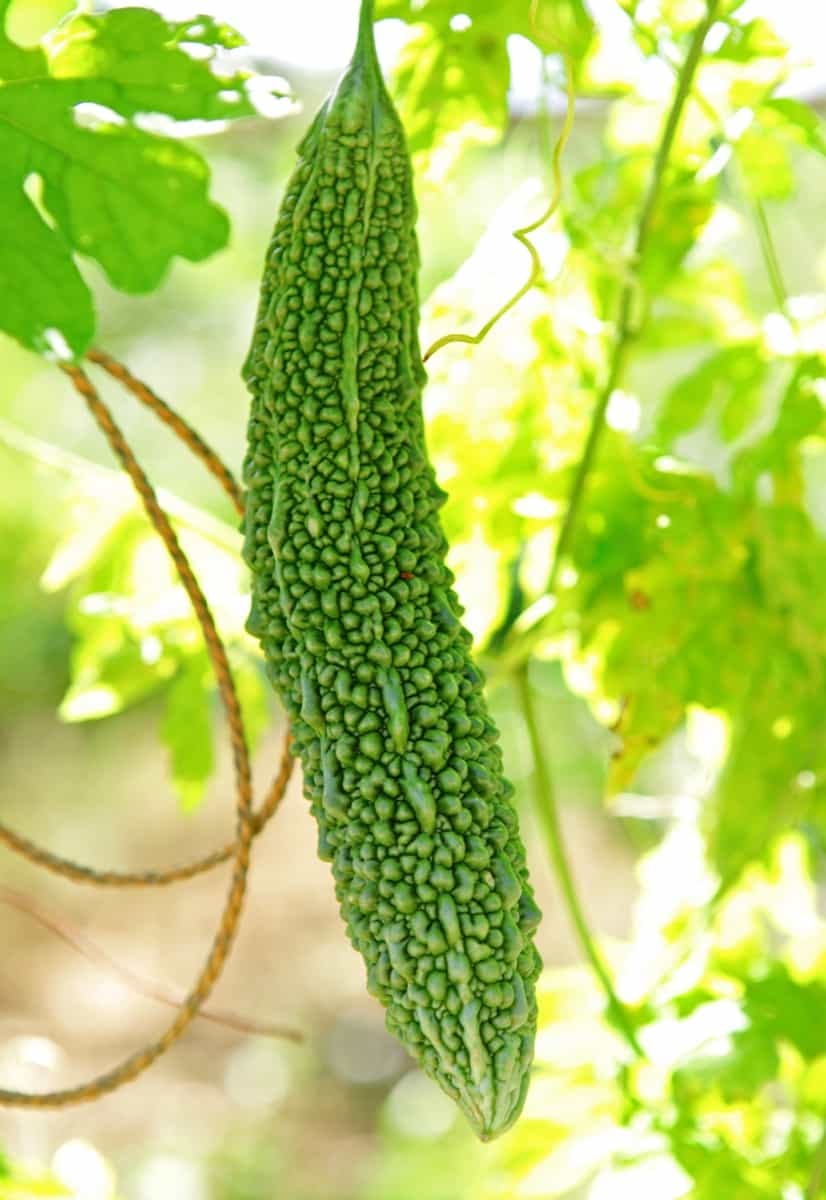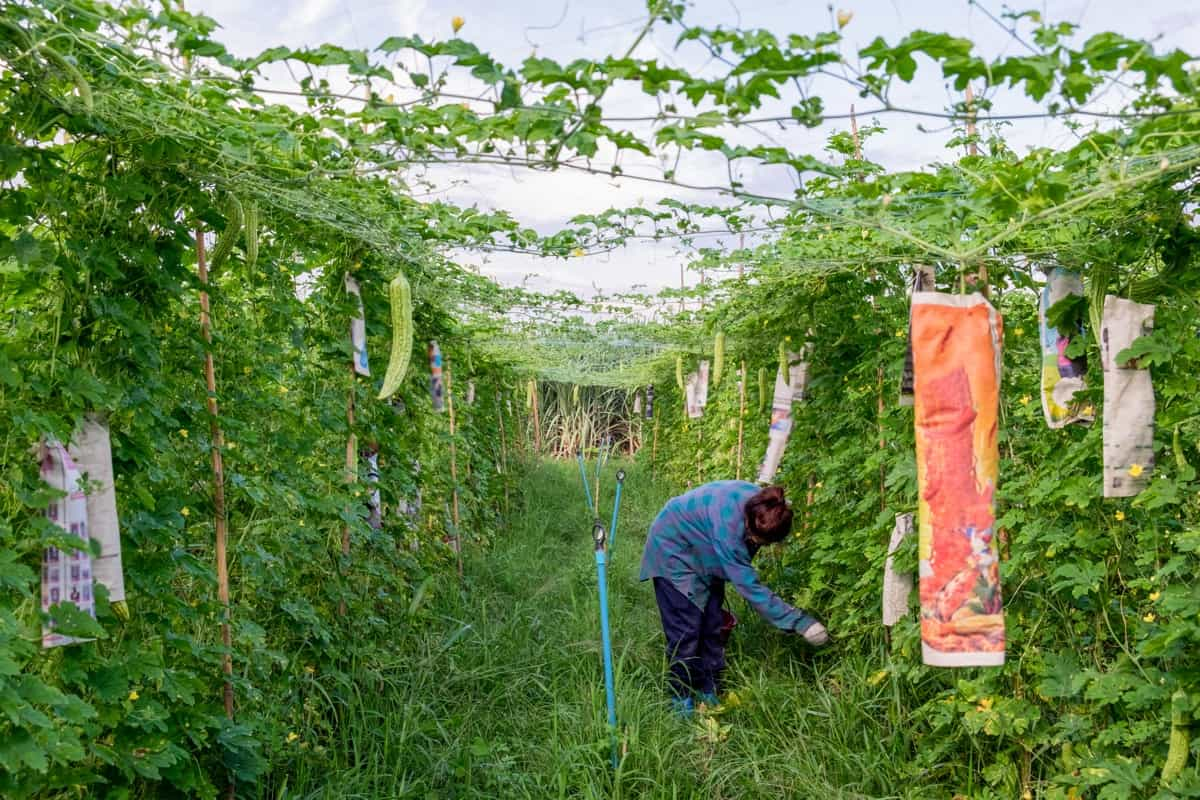Bitter Gourd farming is the art of cultivating this unique and nutritious vegetable, also known as bitter melon or karela. It belongs to the Cucurbitaceae family and is characterized by its distinctively bitter taste and oblong shape. Its scientific name is Momordica charantia. Monitoring growth and development allows farmers to make timely adjustments as needed to maximize yields.

Bitter Gourd Varieties
Several varieties of Bitter Gourd are available, each with unique characteristics and benefits. Some popular varieties include Indian Round, Chinese Long, Hybrid Green Gold, and Taiwan Bitter Gourd. The Indian Round variety is well-known for its round shape and dark green color. It has a slightly bumpy surface and is commonly used in various culinary dishes for its bitterness that adds depth to recipes. On the other hand, the Chinese Long Bitter Gourd features an elongated shape with light green skin.
This variety is preferred for its mild bitterness compared to other types of Bitter Gourds. Hybrid Green Gold is a hybrid variety that combines the best traits of different Bitter Gourd types. It boasts high yields and disease resistance, making it a popular choice among farmers. Taiwan Bitter Gourd is another sought-after variety known for its slender size and intense bitterness. Its different flavor makes it a favorite ingredient in Asian dishes.
Climate Requirements for Bitter Gourd
Bitter Gourd, also known as bitter melon, thrives in warm and humid climates. It is a sun-loving plant that needs plenty of sunlight to produce healthy fruits. The ideal temperature for Bitter Gourd farming is 25°C and 30°C during the morning and not below 15°C at night. Extreme temperatures can hinder the plant’s growth and development.
Additionally, Bitter Gourd plants are sensitive to frost, so it is essential to avoid planting them in areas prone to sudden temperature drops. In cooler regions, it is recommended that Bitter Gourds be started growing indoors or in a greenhouse before transplanting them outside once the weather warms up.
Soil Requirements for Bitter Gourd
Bitter Gourd thrives in well-drained soil with a pH level between 6.0 and 7.0, rich in organic matter. To ensure proper nutrient availability for the plant’s growth, it is important to prepare the soil by applying compost or well-rotted manure before planting. Avoid waterlogged areas, as Bitter Gourd plants are susceptible to root rot under excessive moisture conditions.
In case you missed it: Best Fertilizer for Bitter Gourd: Organic, Natural, Homemade, NPK Ratio, When and How to Apply

Sandy loam soil is preferred for Bitter Gourd cultivation due to its good drainage properties, which help prevent water stagnation around the roots. To maintain consistent moisture without overwatering, regularly check soil moisture levels and adjust irrigation practices accordingly. Monitor the soil’s nutrient content regularly throughout the growing season and supplement with balanced fertilizers as needed to promote healthy vine development and fruit production.
Seed Selection and Treatment
Start by choosing high-quality seeds from reputable suppliers known for their superior genetics and germination rates. Before planting, consider treating the seeds with fungicides or biocontrol agents to protect them against soil-borne diseases. This step can help ensure healthy seedlings and robust plant growth throughout the season.
Seed treatment methods such as soaking in water or using natural stimulants can also improve germination rates and promote strong root development. Experimenting with different treatments may lead to higher yields and better overall plant health. Remember that each crop is unique, so it’s essential to research specific seed selection and treatment techniques tailored to Bitter Gourd cultivation.
Planting Techniques for Bitter Gourd
Start by preparing the soil well, ensuring it is rich in organic matter and has good drainage. Select healthy seeds for planting; soaking them in water overnight can help with germination. Plant the Bitter Gourd seeds directly into the soil or start them indoors before transplanting. Make sure to space out the seeds or seedlings adequately to allow for proper growth. Bitter Gourd plants thrive in sunny locations with plenty of sunlight, so choose a spot accordingly.
Provide regular watering, especially during dry periods, but do not overwater the Bitter Gourd, as this can lead to root rot. Use mulch around the plant base to retain moisture and suppress weeds. As the Bitter Gourd plants grow, provide support such as trellises or stakes for them to climb on. Regularly monitor their progress and adjust care practices as needed throughout the growing season.
Irrigation Methods for Bitter Gourd
Bitter Gourd thrives in moist soil, so proper irrigation is crucial. One common method is drip irrigation, which delivers water to the plants’ roots. This method helps conserve water by minimizing evaporation and runoff. Another effective technique is furrow irrigation, where shallow trenches are made between rows of plants, and water flows through them.
This method allows for efficient watering while reducing weed growth around the plants. Sprinkler irrigation can also be utilized, especially in larger-scale Bitter Gourd farms. Water is distributed overhead in a controlled manner to ensure even coverage across the field.
Nutrient Management
Bitter Gourds are heavy feeders, requiring a balanced supply of nutrients throughout their growth stages. Nitrogen, phosphorus, and potassium are crucial for Bitter Gourd plants’ development. Nitrogen promotes leafy growth, phosphorus supports root development and flowering, and potassium enhances fruit quality. Organic fertilizers can be beneficial in enriching the soil with necessary nutrients.
In case you missed it: Growing Bitter Gourd Organically in Karnataka: Farming Practices and Production Management

Additionally, using foliar sprays containing micronutrients like iron and zinc can help address any deficiencies that may arise during the growing season. Regular soil testing is important to assess nutrient levels accurately and adjust fertilizer applications accordingly. By maintaining a well-balanced nutrient regimen, farmers can optimize their Bitter Gourd production and ensure healthy crops year after year.
Pest Control Strategies
Some common pests that may affect Bitter Gourd include aphids, fruit flies, and spider mites. If left unchecked, these invaders can wreak havoc on your crops. Aphids cause yellowing and distortion of leaves. Fruit flies are attracted to ripe vegetables, laying eggs that hatch into maggots inside the produce. Spider mites are known for their webbing on plants and sucking the juices from leaves, leading to wilting.
To combat these pests, consider using natural predators like ladybugs or lacewings. Also, neem oil or insecticidal soap can help control aphids and spider mites effectively. Regular monitoring of your crops is essential to catch pest infestations early before they cause significant damage. Implementing integrated pest management practices can help maintain a healthy balance in your Bitter Gourd farm ecosystem while minimizing the harmful chemicals.
Disease Management
Like any agricultural venture, Bitter Gourd farming is susceptible to various diseases that can hinder crop productivity. Some common diseases that farmers need to watch out for include powdery mildew, downy mildew, bacterial wilt, and viral infections. Powdery mildew appears as white powdery spots on the leaves of the plant, affecting photosynthesis and nutrient absorption. Downy mildew causes leaves to yellow with fuzzy growth underneath. Bacterial wilt leads to wilting and death of vines in severe cases.
Viral infections can cause mosaic patterns on leaves or stunted growth. Implementing proper sanitation practices, crop rotation techniques, and disease-resistant Bittergourd varieties can help manage these issues effectively. Regular monitoring of the plants for early detection of symptoms is crucial in preventing widespread outbreaks that could drastically impact harvest yield.
Weed Management Techniques
Various techniques can be employed to effectively control weeds without harming the crop. One common method is hand weeding, which involves manually removing weeds from the soil. This labor-intensive technique is effective for small-scale farms. Another approach is mulching, which involves covering the soil around the Bitter Gourd plants with a layer of organic material like straw or grass clippings. Mulching helps control weed growth by blocking sunlight and preventing weed seeds from germinating.
Crop rotation is also a useful strategy to reduce weed pressure. By alternating Bitter Gourd with other crops, it disrupts the life cycle of weeds that thrive on monoculture systems. Additionally, using cover crops can help smother weeds and improve soil health simultaneously. These companion plants act as living mulch, suppressing unwanted vegetation while adding nutrients back into the soil. Implementing a combination of these weed management techniques can help maintain a healthy environment for Bitter Gourd plants and maximize farm productivity.
Training and Pruning Practices
By carefully training the vines to grow along trellises or supports, you can maximize space utilization and facilitate proper air circulation around the plants. Pruning helps remove damaged parts of the plant, allowing for better nutrient distribution to healthy areas. Regularly trimming excess foliage encourages the development of strong stems and promotes flowering, leading to increased fruit yields.
In case you missed it: How this Farmer Earning 25 Lakh Rupees from his Bitter Gourd Farm: A Success Story to Inspire

Pruning selectively, focusing on removing overcrowded or tangled branches while preserving vital leaves for photosynthesis, is important. Additionally, training the vines vertically can help prevent diseases by reducing ground contact and improving sunlight exposure.
Monitoring Growth and Development
Once you have planted your Bitter Gourd crop, it is essential to monitor its growth and development closely. Regularly check the Bitter Gourd plants for any signs of nutrient deficiencies, pests, or diseases. Keep an eye on the vines as they grow and ensure proper spacing to avoid overcrowding. Measuring the growth rate of your Bitter Gourd plants can help you anticipate their needs for water, nutrients, and support structures.
Observing the flowering patterns can give insights into potential fruit production levels. Take note of any abnormalities in plant growth early on to address issues promptly. Tracking the development of fruits is crucial for determining the optimal time for harvesting. Monitor their size, color, and firmness regularly as they mature. Adjust your cultivation practices based on how the plants are progressing throughout their lifecycle.
Harvesting Bitter Gourd
Timing is key when it comes to Bitter Gourd harvesting. Bitter Gourds should be harvested when they reach a mature size but are still tender. To harvest Bitter Gourd, use a sharp knife to cut the fruits from the vine carefully. Be gentle to avoid damaging the plant and ensure a clean cut for better healing post-harvest. Remember not to pull or twist the fruit off the vine as this can harm both the fruit and plant.
Inspect each Bitter Gourd for firmness, color, and size before harvesting. Ideally, they should be bright green with no signs of yellowing or browning. Harvest regularly to encourage continuous production throughout the growing season. Once harvested, handle Bitter Gourds with care to prevent damage that could affect their shelf life and market value. Store Bitter Gourds in a cool place away from direct sunlight until ready for sale or consumption.
Post-Harvest Handling and Storage
After all the hard work put into growing Bitter Gourds, it’s crucial to handle and store them properly post-harvest to maintain their quality. Once harvested the Bitter Gourd, remove any dirt or debris from the gourds. Avoid bruising them as it can lead to spoilage. Before storing, sort the gourds based on size and ripeness. Discard any damaged or overripe ones, as they can affect the rest. Choose a well-ventilated area with low humidity for storage to prevent mold growth.
Bitter Gourds should be stored at 10-15°C for optimal freshness. Avoid storing Bitter Gourd near fruits that produce ethylene gas, as this can accelerate ripening. Regularly check stored Bitter Gourds for signs of spoilage like soft spots or mold. Use up any ripe gourds first before moving on to less ripe ones.
Marketing and Economics of Bitter Gourd Farming
Consider selling directly to consumers at farmers’ markets or grocery stores. Explore online platforms for wider reach and visibility. Building relationships with local restaurants and chefs can also be a lucrative avenue for sales. In terms of economics, the profitability of Bitter Gourd farming depends on factors like yield per acre, input costs, and market prices. Conducting thorough research and staying updated on industry trends can help maximize profits.
In case you missed it: Types of Pesticides Used in Agriculture: A Beginner’s Guide

Implementing cost-effective practices such as efficient irrigation methods and integrated pest management can contribute to overall economic sustainability. Diversifying your product offerings by creating value-added products like pickled Bitter Gourd or powdered supplements can open up new revenue streams. Collaborating with other farmers or agriculture organizations for joint marketing efforts can further enhance the economic viability of your Bitter Gourd farm.
Stay adaptable to changing market conditions to thrive in the competitive agricultural landscape. Bitter Gourd farming can be a rewarding venture for farmers looking to diversify crops and tap into the demand for this nutritious vegetable. By following these techniques, farmers can successfully cultivate Bitter Gourd while maximizing yields and quality.
- Types of Pesticides Used in Agriculture: A Beginner’s Guide
- Economical Aquaculture: A Guide to Low-Budget Fish Farming
- 15 Common Planting Errors That Can Doom Your Fruit Trees
- How to Make Houseplants Bushy: Effective Tips and Ideas
- Innovative Strategies for Boosting Coconut Pollination and Yield
- Pollination Strategies for Maximum Pumpkin Yield
- The Complete Guide to Chicken Fattening: Strategies for Maximum Growth
- Natural Solutions for Tulip Problems: 100% Effective Remedies for Leaf and Bulb-Related Issues
- Revolutionizing Citrus Preservation: Towards a Healthier, Greener Future
- Natural Solutions for Peony Leaf and Flower Problems: 100% Effective Remedies
- Maximizing Profits with Avocado Contract Farming in India: A Comprehensive Guide
- Natural Solutions for Hydrangea Problems: 100% Effective Remedies for Leaf and Flowers
- The Ultimate Guide to Choosing the Perfect Foliage Friend: Bringing Life Indoors
- From Sunlight to Sustainability: 15 Ways to Use Solar Technology in Agriculture
- The Ultimate Guide to Dong Tao Chicken: Exploring from History to Raising
- The Eco-Friendly Makeover: How to Convert Your Unused Swimming Pool into a Fish Pond
- Mastering the Art of Delaware Chicken Farming: Essentials for Healthy Backyard Flocks
- 20 Best Homemade Fertilizers for Money Plant: DIY Recipes and Application Methods
- How to Craft a Comprehensive Free-Range Chicken Farming Business Plan
- Brighten Your Flock: Raising Easter Egger Chickens for Beauty and Bounty
- How to Optimize Your Poultry Egg Farm Business Plan with These Strategies
- Subsidy for Spirulina Cultivation: How Indian Government Schemes Encouraging Spirulina Farmers
- Ultimate Guide to Raising Dominique Chickens: Breeding, Feeding, Egg-Production, and Care
- Mastering the Art of Raising Jersey Giant Chickens: Care, Feeding, and More
- Ultimate Guide to Raising Legbar Chickens: Breeding, Farming Practices, Diet, Egg-Production
- How to Raise Welsummer Chickens: A Comprehensive Guide for Beginners
- How to Protect Indoor Plants in Winter: A Comprehensive Guide
- Ultimate Guide to Grow Bag Gardening: Tips, Tricks, and Planting Ideas for Urban Gardeners
- Guide to Lotus Cultivation: How to Propagate, Plant, Grow, Care, Cost, and Profit
- Agriculture Drone Subsidy Scheme: Government Kisan Subsidy, License, and How to Apply Online
- Ultimate Guide to Raising Araucana Chickens: Breed Profile, Farming Economics, Diet, and Care
- Bringing Hydroponics to Classroom: Importance, Benefits of Learning for School Students
- Ultimate Guide to Raising Polish Chickens: Breed Profile, Farming Economics, Diet, and Care
- Ultimate Guide to Raising Australorp Chickens: Profile, Farming Economics, Egg Production, Diet, and Care
- Silkie Chicken Farming: Raising Practices, Varieties, Egg Production, Diet, and Care
- Sussex Chicken Farming: Raising Practices, Varieties, Egg Production, Diet and Care
How can I receive your newsletter regularly on farming/gardening.
Thanks.
We will ass a functionality to send a news letter for e-mail subscribed members soon.
Thanks for sharing your experience.